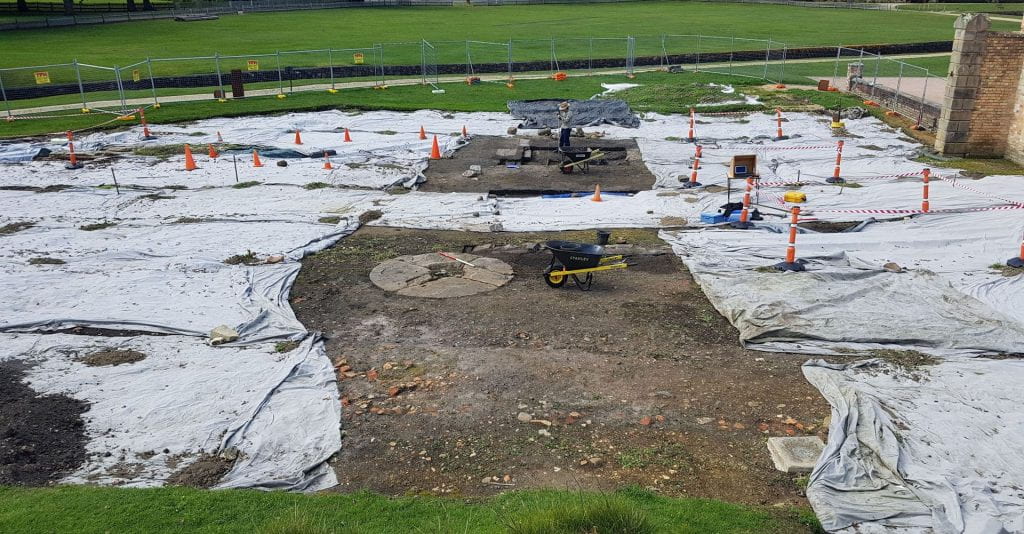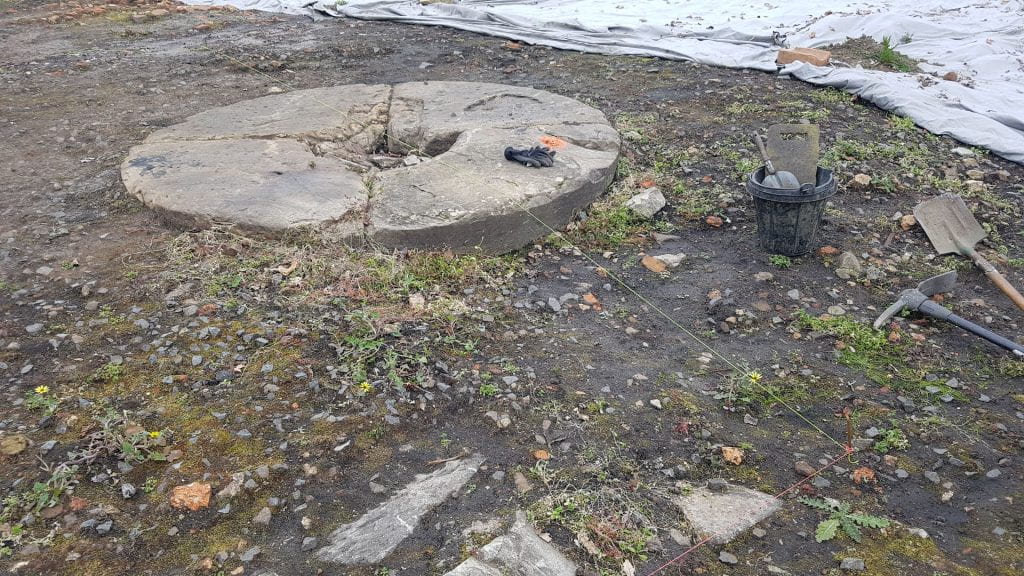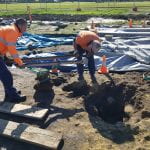…when you’ve got your head in a hole. It’s already the end of Week 3! Well, as we’re working 3-day weeks it really is only the equivalent of Day 8…but you get my idea.
A few things have been happening on the site. Most importantly, I have lost my sunglasses. They are really cool aviators which make me look like a boss. I am currently wearing a pair of wraparound sunglasses which make me look like I play sport and wear zinc cream. Urgh.
Anyway. Archaeology. We’ve been doing a bit. Sylvana and I have been sequestered away in our separate squares, each of which forms part of the big trench we are excavating as part of Stage 1. Sylvana is working in the area equating with the former workshops frontage (to the north, for those who care about cardinal directions). This area was the site of the wood shed and steam boiler from 1856. Sylvana is currently puzzling out an intriguing mixture of robber cuts (from when the building was salvaged), original cuts for a possible drain and footing, as well as deliberately laid flooring material (crushed brick, sandstone, mortar and other detritus). I will put an update on this when I take a picture. As we go down further we will find evidence of the earlier reclamation and, hopefully, waterfront. This plan in the Tasmanian Archives shows the ca.1836 workshops range that was present in the area until the site was remade in 1856. We think that Sylvana’s square is right in the area where the building fronted the bay. So, we hope to find evidence of sea defences…and maybe the original rocky shoreline. On that day I will bring my beach umbrella.
Apart from standing around looking confused (and like I should be fielding in the slips or some rubbish), I have opened up a couple of different squares. In the photo above, you can see a strip of geofabric (grey material) across the middle of the trench. This is covering a mistake. Not a bad one, but just a bit of overzealous poking of a deposit that probably should not have been poked that hard. Indications are that the foundry (from 1856) floor is actually very, very shallow and quite fragile. We’ve therefore changed the plan a bit and are leaving the entirety of the foundry internal space to Stage 2, when we can give it the love and TLC that it really deserves.
I have instead moved up the slope a bit to the site of the mechanics’ yard. As you can see from the photo above I am working in the square with the round thing. Joy of joys! Over the last two days I have taken off the overlying gravel (and garden) and exposed a secondary gravel layer. This one is much darker, formed from broken dolerite (bluestone) with charcoal, coal and lots of iron fragments across it. Underneath this is another yard surface, made from bluestone and brick rubble. This latter one has been cut by the sandstone footing of the foundry. This suggests that it is definitely pre-1856 – however, if the foundry footing is reused from an earlier 1830s building, then this last gravel layer could be 1830s provenance. That’s old! (well, in terms of historical archaeology in Australia – my mean prehistoric-loving friends in the UK would call it ‘current affairs’, but what do they know? They think everything is ritualistic and full of DEEP MEANING).
Anyway, will follow this up with some more pics of our squares and a bit of a discussion about dolerite. Cos’ dolerite is ace.





Another fascinating post! I’m looking forward to reading your take on dolerite Richard, and how it informs us of the history of the region. I imagine it shaped the natural and built landscape in profound ways, being such a hard stone and no doubt quarried by hand.
Johnathon. You’re back! And full of questions too. Dolerite? Yes, a magnificent stone. Versatile. You can use it for roads, footings and…errr. Ok. Not that much really. It’s rock-hard, so provided the authorities with the perfect opportunity for hard – but productive labour. There are a number of convict accounts talking about stone-breaking as a punishment – if you knew the knack of how to break stone, it made labour easier.
Dear Richard, I would be interested in learning of the knack to breaking stone (it would save my teeth when eating my wife’s scones ha ha!).
Johnathon. Well, I have to say I am a big fan of rock cakes.
We don’t have a lot of historical information (from Port Arthur) about the technique. A bar and hammer would have been used for quarrying. A hammer was used for breaking.